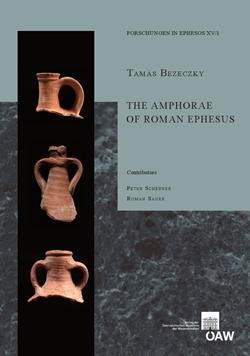

The Amphorae of Roman Ephesus , pp. 25-34, 2015/03/12

Most of the 621 amphorae discussed in the book come from the Ephesian Tetragonos Agora with lesser amounts from a range of sites both within the town and beyond. The work begins with a brief historical background providing the reader with an idea of the context of the material under study. This is followed by a detailed description and analysis of the archaeological context of each of the eight sites at which material was found, with a particular focus on the stratigraphic context (contribution by Peter Scherrer). Chapter 3, concerning the Ephesus and Cayster Valley Food and Amphora Production, provides evidence (petrology and epigraphy) for the existence of an Ephesian amphora production extending between the Hellenistic and Late Roman periods: since these types are widely distributed they offer a touchstone for characterizing the distribution of Ephesian agricultural products across the Mediterranean. The main body of the book is a type-by-type description of all the seventy amphora types encountered during the study. This part focuses upon form, chronology, contexts at Ephesus, epigraphy (stamps), origins, contents, distribution, fabric (and petrology), and a catalogue of identified pieces. The different types of amphorae present at Ephesus are subdivided into the Late Hellenistic, Early Roman, Mid-Roman and Late Roman periods, providing us for the first time with an idea of the main periods of amphora-based commercial activity at Ephesus, as well as of the relative importance of the different production areas in the commercial life of the city. The book is then rounded off by a discussion of the petrology by Roman Sauer (Chapter 7), and is complemented by appendices on two different classes of stamped amphorae (Appendices I and II) and an extensive bibliography.
Gedruckt mit Unterstützung des Fonds zur Förderung der wissenschaftlichen Forschung (FWF).

…
Im vorliegenden Werk werden 621 Amphoren bzw. -fragmente vorgestellt und ausgewertet, die zum Großteil vom Handelsmarkt (Tetragonos Agora) in Ephesos stammen. Darüber hinaus finden aber auch Funde aus der übrigen Stadt sowie ihrer näheren Umgebung Berücksichtigung. Die Publikation beginnt mit einer kurzen Einführung in den geschichtlichen Hintergrund des untersuchten Materials. Auf diese folgen eine genaue Beschreibung der Fundstellen sowie eine detaillierte Analyse unter besonderer Berücksichtigung der Stratigraphie (unter Mitwirkung von Peter Scherrer). Ein Kapitel, das sich mit der Amphoren- und Nahrungsmittelproduktion in Ephesos und dem Kaystrostal beschäftigt, untermauert den Nachweis einer lokalen Amphorenproduktion zwischen der hellenistischen und der spätrömischen Periode durch petrographische und epigraphische Studien. Die weite Verbreitung dieser Amphoren erlaubt im Übrigen konkrete Aussagen zum Handel mit landwirtschaftlichen Produkten aus Ephesos im gesamten Mittelmeerraum. Im Zentrum der Untersuchungen stehen aber detaillierte Studien zu den zahlreichen Amphorentypen, wobei besonderes Augenmerk etwa auf die Form, den Inhalt, epigraphische Evidenzen (Stempel) und auch das Material gelegt wird. Ein umfassender Katalog der identifizierten Stücke ist angeschlossen. Durch die chronologische Einordnung der verschiedenen Amphoren (späthellenistische, früh-, mittel- und spätrömische Perioden) gelingt es zudem, erstmals auch ein Bild der kommerziellen Amphorenproduktion in Ephesos sowie der Bedeutung der verschiedenen Produktionsorte im Wirtschaftsleben der Stadt zu zeichnen. Das Werk wird durch petrologische Studien von Roman Sauer vervollständigt und bietet außerdem in zwei Appendizes Vergleiche mit anderen gestempelten Amphoren sowie eine ausführliche Bibliographie.